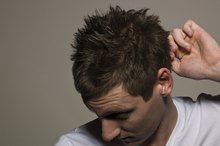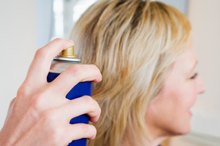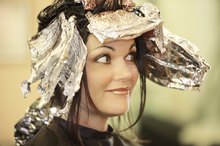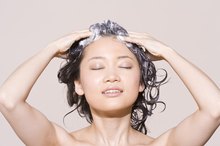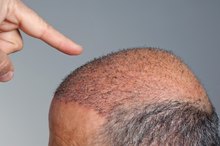Allergic Reaction to Hair Dye & Head Itching
Millions of women and men use hair dye to enhance, update or change up their look. Most people tolerate hair dye without a problem, but it can cause a reaction in some users. These reactions, known as contact dermatitis, are due to various chemicals in different types of hair dye 25. Symptoms include scalp redness, flaking, itchiness, and burning or stinging. Contact dermatitis caused by hair dye can be due to direct chemical irritation of the scalp or an allergic reaction 3. Since irritant and allergic contact dermatitis frequently cause the same symptoms, medical testing is often needed to determine whether you have an allergy to hair dye.
Chemical Culprits
Para-phenylenediamine (PPD) is a key ingredient found in the majority of permanent and semipermanent hair dyes. It's also the most common cause of an allergic reaction to hair coloring. There are PPD-free hair dyes, which frequently contain an alternative chemical called para-toluenediamine sulfate (PTDS). However, a significant number of people who are allergic to PPD also react to PTDS, according to a study published in the July-August 2011 issue of "Dermatitis." Other chemicals in hair dyes -- such as ammonia, peroxide, and various fragrances and pigments -- can also trigger scalp inflammation and itchiness due to either direct irritation or an allergic reaction 3.
- Para-phenylenediamine (PPD) is a key ingredient found in the majority of permanent and semipermanent hair dyes.
- However, a significant number of people who are allergic to PPD also react to PTDS, according to a study published in the July-August 2011 issue of "Dermatitis."
Symptom Severity and Timing
Allergic Reaction to Hair Product: Scaly Dry Rash on Neck
Learn More
Symptoms of an allergic reactions to hair dye can develop within 1 to 48 hours of application 2. Redness accompanied by burning, stinging and itchiness typically predominate and are usually most noticeable at the hairline and nape of the neck. These symptoms can vary from mild to severe and may be accompanied by swelling around the eyes. Blisters can develop with severe reactions. Although rare, an allergy to hair dye can cause:
- a life-threatening reaction called anaphylaxis
- with symptoms including difficulty breathing
- throat tightness
- lightheadedness
- widespread hives
- among others
- Symptoms of an allergic reactions to hair dye can develop within 1 to 48 hours of application 2.
- Redness accompanied by burning, stinging and itchiness typically predominate and are usually most noticeable at the hairline and nape of the neck.
Treatment and Follow Up
As long as there are no other symptoms present, mild scalp redness and itchiness related to hair dye can often be managed at home. Washing the hair with a mild shampoo will remove any residual hair dye on the scalp. An over-the-counter antihistamine such as diphenhydramine (Benadryl) might help with scalp itchiness, but can cause drowsiness. Avoiding use of a hair dryer and styling tools and products for a few days gives the scalp time to heal without further irritation 3. See your doctor if you have scalp irritation related to hair dye that persist for more than 2 days or is severe 3. Seek emergency medical care if you develop difficulty breathing or any other symptoms of anaphylaxis.
- As long as there are no other symptoms present, mild scalp redness and itchiness related to hair dye can often be managed at home.
Prevention
Allergies to Hairspray
Learn More
Hair dye manufacturers recommend a spot skin test 48 hours before applying the product to the hair. This involves mixing a small amount of the product and applying it to an area such as the inside of the elbow or behind the ear, allowing it to dry, and watching for a skin reaction. If no reaction occurs, it's unlikely the product will trigger an allergic reaction when used on the hair. Spot skin testing before use of hair dye is especially important if you've previously experienced a reaction to hair color, have other allergies, or live with a long-term skin condition such as eczema or psoriasis.
Reviewed by: Tina M. St. John, M.D.
- Hair dye manufacturers recommend a spot skin test 48 hours before applying the product to the hair.
- This involves mixing a small amount of the product and applying it to an area such as the inside of the elbow or behind the ear, allowing it to dry, and watching for a skin reaction.
Related Articles
References
- Dermatitis: Alternative Hair-dye Products for Persons Allergic to Para-phenylenediamine
- NHS Choices: Hair Dye Reactions
- The Dermatologist: Scalp Irritation
- DermNet NZ: Allergy to Paraphenylenediamine
- Indian Journal of Dermatology, Venereology and Leprology: Contact Dermatitis to Hair Dye: An Update
- The Journal of Allergy and Clinical Immunology: In Practice: Contact Dermatitis: A Practice Parameter Update 2015
- Han JH, Lee HJ, Bang CH, Lee JH, Park YM, Lee JY. P-Phenylenediamine Hair Dye Allergy and Its Clinical Characteristics. Ann Dermatol. 2018;30(3):316-321. doi:10.5021/ad.2018.30.3.316
- National Health Service. Hair Dye Reactions.
- Centers for Disease Control and Prevention. The National Institute for Occupational Safety and Health.
Writer Bio
Kay Ireland specializes in health, fitness and lifestyle topics. She is a support worker in the neonatal intensive care and antepartum units of her local hospital and recently became a certified group fitness instructor.
